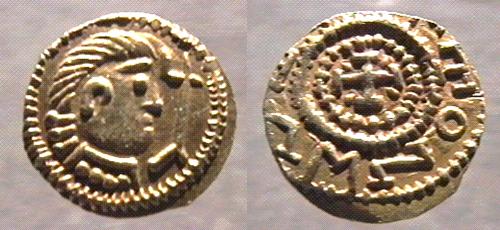
Original, shown much enlarged.
Taynton Metal Detecting Club
The Gannets
Thrymsa

Original, shown much enlarged.

Replica, shown much enlarged.
This Thrymsa was found by David Hutton in a field near Newent. It is the only Thrymsa ever known to be found in this part of Britain. It is now on display in Gloucester City Museum.
Gloucester City Museum report on the Newent Anglo Saxon Thrymsa
Thrymsa's were the first native Anglo Saxon coinage to be produced in England. They are hammered coins, hand made by striking a blank between two dies, the method of coin making which persevered in this country from the first century BC to the 17th century.
With the departure of the Romans in the early fifth century supplies of coins soon dried up, and it is argued that no coins were circulated between the middle of the 5th century and the second half of the 6th century, when small quantities of Merovingian coins (tremisses) began to enter the country. In the late 6th century, coins based on tremisses were first produced in England. These gold thrymsas continued to be minted until around 675, when silver sceattas, essentially debased thrymsas, superseded them.
There are a number of different types of thrymsa, but all are very rare. As noted above, the first were based on the Merovingian tremissis, but others were based on Roman prototypes or were purely Anglo-Saxon in style with runic or meaningless Latin legends. It is thought that there were mints in London and Kent, and possibly York. Wuneetton type thrymsas are thought to be derived from Witmen type thrymsas, and are mainly found, and presumably minted, around London and Kent. Names 'Wunetton' and 'Witmen' come from the coins' Latin legends, perhaps personal names, sometimes blundered and including runes. The Crondall hoard was discovered in 1828 and provides the main source of information on these thrymsas. The hoard is dated to AD 620 - 630's and contained Witmen type but not Wunetton type thrymsas. This and stylistic and metallurgical grounds indicate a date of c 650 for Wunetton type thrymsas. There are only six other recorded Wunetton type thrymsa’s and this example is particularly exciting, being the furthest West yet found and of a unique sub-type. Gareth Williams of the British Museum has stated that 'the pellets in the angle of the cross on the reverse represent a sub-type which to the best of my knowledge is otherwise unknown'. It is the only known Thrymsa from Gloucestershire.
Early Medieval Corpus of Coin Finds
The Thyrmsa is registered with the Corpus as EMC Number: 1999.0127 To find the coin you will need to fill in the search page on the EMC website as indicated below:
